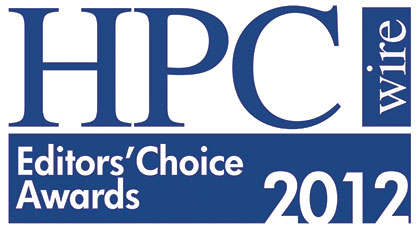

 Skip to navigation
Skip to navigation
Site Primary Navigation:
- About SDSC
- Services
- Support
- Research & Development
- Education & Training
- News & Events
Search The Site:

Published 11/14/2012

The San Diego Supercomputer Center (SDSC) at the University of California, San Diego, has been recognized by HPCwire, a top online publication covering high-performance computing and related technologies, for the Center’s innovative Data Oasis parallel file storage system.
SDSC was presented with ‘Editor’s Choice: Best HPC Storage Product or Technology, for the Data Oasis Storage File System on Gordon’ as part of the publication’s annual HPCwire Readers’ and Editors’ Choice Awards. The awards were announced at the 2012 International Conference for High-Performance Computing, Networking, Storage and Analysis (SC12) in Salt Lake City, Utah. The complete list of winners is available here.
SDSC earlier this year completed deployment of its Lustre-based Data Oasis parallel file system, with has four petabytes (PB) of capacity and 100 gigabytes per second (GB/s) to handle the data-intensive needs of the center’s new Gordon supercomputer, in addition to its Trestles and Triton compute clusters.
Data Oasis ranks as one the fastest parallel file systems in the academic community. The sustained speeds mean researchers can retrieve or store 64 terabytes (TB) of data – the equivalent of Gordon’s entire DRAM memory – in about 10 minutes, significantly reducing research times needed for retrieving, analyzing, storing, or sharing extremely large datasets.
“We're excited to be recognized by the editors of HPCwire about the significance of Data Oasis,” said Phil Papadopoulos, SDSC’s chief technical officer who is responsible for the center’s data storage systems.
The system is built using all 10Gbit/s Ethernet with redundant network paths from every server for performance. Data Oasis delivers about 100 GB/s through 64 storage servers, and is available from several clusters through two Arista 7508 switches that, together, have more than 550 provisioned 10GbE ports.
“We worked closely with both Arista and Aeon Computing to build what we believe to be one the one of the largest and fastest all-Ethernet parallel file systems, all at a remarkably low cost,” added Papadopoulos.
In addition, Whamcloud provided SDSC with consulting expertise in building the system’s Lustre environment, including hardware, networking, interfaces to various HPC systems, and software installation.
“We view Data Oasis as a solution for coping with the data deluge going on in the scientific community, by providing a high-performance, scalable storage system that many of today’s researchers need,” said SDSC’s director Michael Norman at the launch of Data Oasis. “We are entering the era of data-intensive computing, and that means positioning SDSC as a leading resource in the management of ‘big data’ challenges that are pervasive throughout genomics, biological and environmental research, astrophysics, Internet research, and business informatics, just to name a few.”
“Multi-scale simulations of oceanic circulation and biogeochemistry generate large data files, and Data Oasis is a valuable resource in manipulating them,” said James McWilliams, Louis B. Slichter Professor of Earth Sciences at UCLA’s Institute of Geophysics and Planetary Physics and Department of Atmospheric and Oceanic Sciences. McWilliams is using SDSC’s compute and storage systems to create simulations of oceanic circulation that includes data on water quality, biogeochemistry, sediment movement, and planktonic ecosystem population dynamics.
The HPCwire Readers’ and Editors’ Choice Awards are determined through online polling of the global HPCwire audience for the Readers’ Choice Awards, combined with a rigorous selection process for the Editor’s Choice Awards, where winners are selected by a panel of editorial and executive staff, recognized HPC luminaries, and contributing editors from across the industry. The awards hold the unique distinction of being recognized as the most prestigious recognition given by the HPC community to its own each year.
“It’s an honor and a privilege to take time during the most important supercomputing conference globally to acknowledge the organizations and the individuals behind them who exemplify the hard work, dedication, and effort that has taken place the past year to develop new technologies that ultimately benefit mankind,” said Jeff Hyman, president and group publisher of Tabor Communications Inc., which publishes HPCwire.
About HPCwire
HPCwire is the top news and information portal covering the fastest computers in the world and the people who run them. Dating back to 1986, HPCwire continues to be the publication of choice globally by business and technology professionals from academia, government, science, and industry who are interested in high-performance and computationally intensive computing. For additional information, visit www.hpcwire.com
About SDSC
As an Organized Research Unit of UC San Diego, SDSC is considered a leader in data-intensive computing and all aspects of ‘big data’, which includes data integration, performance modeling, data mining, software development, workflow automation, and more. SDSC supports hundreds of multidisciplinary programs spanning a wide variety of domains, from earth sciences and biology to astrophysics, bioinformatics, and health IT. With its two newest supercomputer systems, Trestles and Gordon, SDSC is a partner in XSEDE (Extreme Science and Engineering Discovery Environment), the most advanced collection of integrated digital resources and services in the world.
Media Contacts:
Jan Zverina, SDSC Communications
858 534-5111 or jzverina@sdsc.edu
Warren R. Froelich, SDSC Communications
858 822-3622 or froelich@sdsc.edu
Caroline Connor, HPCwire/Tabor Communications
510 378-5838 or caroline@taborcommunications.com
San Diego Supercomputer Center: http://www.sdsc.edu/
UC San Diego: http://www.ucsd.edu/
SC12 conference: http://sc12.supercomputing.org/